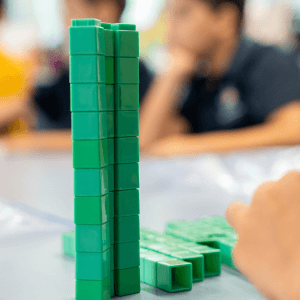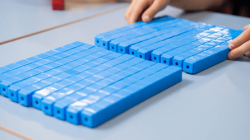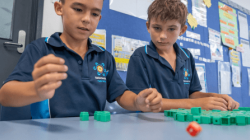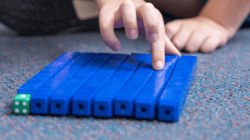'Place Value: Lolly Shop' is one of our new teaching sequences for V9
- On the 'In this sequence' tab you'll find all the tasks in this sequence, a suggested implementation plan and curriculum alignment.
- The 'Behind this sequence' tab shows how key mathematical ideas develop over the sequence.
- Have you taught this sequence? Use the Feedback button to let us know how it went!
Tasks in this sequence
Task 1 • Packing lollies
Students learn that making groups helps us to keep track of the count and facilitates efficient counting strategies.
Task 2 • Rolls and boxes
Students learn to group ones to make tens and group tens to make hundreds, and develop the idea of “10 of these is 1 of those”.
Task 3 • Filling Boxes
Students play a simple game to build their understanding of “10 of these is 1 of those”.
Task 4 • How many?
Students learn that numbers can be represented in different but equivalent ways.
Task 5 • Different Ways
Students play a game building their understanding of different yet equivalent ways to represent a two-digit number.
Task 6 • Counting lollies
Students learn to use ‘10 of these is 1 of those’ to make sense of place value patterns and different but equivalent representations.
Suggested implementation
This time plan is just one way that you might choose to implement this sequence. We have used a warm-up activity at the start of most lessons, and a number of tasks are split across two lessons. The timing provided in the tasks’ documentation align with this implementation advice.
| Week 1 | Week 2 | |
|---|---|---|
| Monday | Task 1 • Packing Lollies
| Task 4 • How many?
|
| Tuesday | Task 2 • Rolls and Boxes
| Task 4 • How many?
|
| Wednesday | Task 2 • Rolls and Boxes
| Task 5 • Different Ways
|
| Thursday | Task 3 • Filling Boxes
| Task 6 • Counting lollies
|
| Friday | Task 3 • Filling Boxes
| Task 6 • Counting lollies
|
Curriculum and syllabus alignment
Achievement standards
In Year 2, students order and represent numbers to at least 1000, apply knowledge of place value to partition, rearrange and rename two- and three-digit numbers in terms of their parts, and regroup partitioned numbers to assist in calculations.
Australian Curriculum V9 alignment
Number
Recognise, represent and order numbers to at least 1000 using physical and virtual materials, numerals and number lines
Partition, rearrange, regroup and rename two- and three-digit numbers using standard and non-standard groupings; recognise the role of a zero digit in place value notation
Sequence design overview
10 of these is 1 of those is foundational to the place value structure of our number system. This sequence is designed to build students’ understanding of this powerful mathematical idea as they investigate that 10 ones are a unit of 1 ten and 10 tens are a unit of 1 hundred.
Sequence framework
| Learning goals | Students’ mathematical activity | Representation | Context | |
|---|---|---|---|---|
| Task 1 | A collection of ones can be grouped together to form a unit. | Students partitioning a collection into equal-sized groups with some left-overs. They use the groups to skip count the total in a collection. | Equal-sized groups with remainders represented as left-overs. | Counting and organising lollies. |
| Task 2 | 10 of these is 1 of those:
| Students count a collection by making groups of 10 ones and 10 tens. Any remainders are represented as left-over ones. | Hundreds as “flats” and tens as “longs” with remainders represented as left-over ones. | Counting and organising lollies into rolls of 10 and boxes 10 rolls which is 100. |
| Task 3 Build | 10 of these is 1 of those:
| Students represent three-digit numbers using hundreds, tens and ones. | Hundreds as “flats” and tens as “longs” with remainders represented as left-over ones. | A game for mindful practice of the key idea that 10 of these is equal to 1 of those. |
| Task 4 | Numbers can be represented using standard base-ten groupings and non-standard groupings. These different representations of the same number are equivalent in value. | Students investigate the value of three-digit numbers represented using standard base-ten groupings and non-standard groupings. | Hundreds as “flats” and tens as “longs” with remainders represented as left-over ones. | Working out how many lollies are in a collection given the number of boxes, rolls and loose lollies. |
| Task 5 Build | Numbers can be represented using standard base-ten groupings and non-standard groupings. These different representations of the same number are equivalent in value. | Students represent a two-digit number using standard base-ten groupings and non-standard groupings. | Hundreds as “flats” and tens as “longs” with remainders represented as left-over ones. | An activity that explores the different, yet equivalent, ways that a two-digit number can be represented. |
| Task 6 | ‘10 of these is 1 of those’ helps us to make sense of the place value patterns that occur when counting in 1s, 10s, and 100s. Numbers can be represented using standard base-ten groupings and non-standard groupings. These different representations of the same number are equivalent in value. | Students represent three-digit numbers using standard base-ten groupings and non-standard groupings. | 100s, 10s and 1s cards to represent numbers. | Counting lollies in Ms Fizz’s Lolly Shop. |







